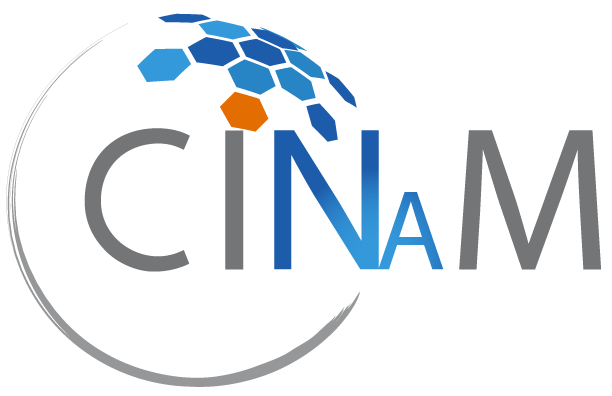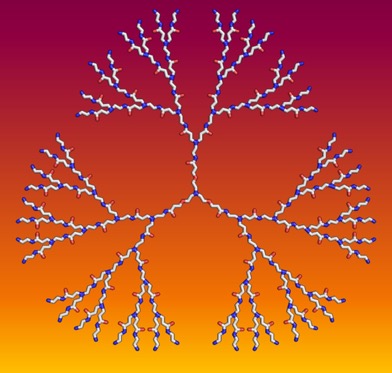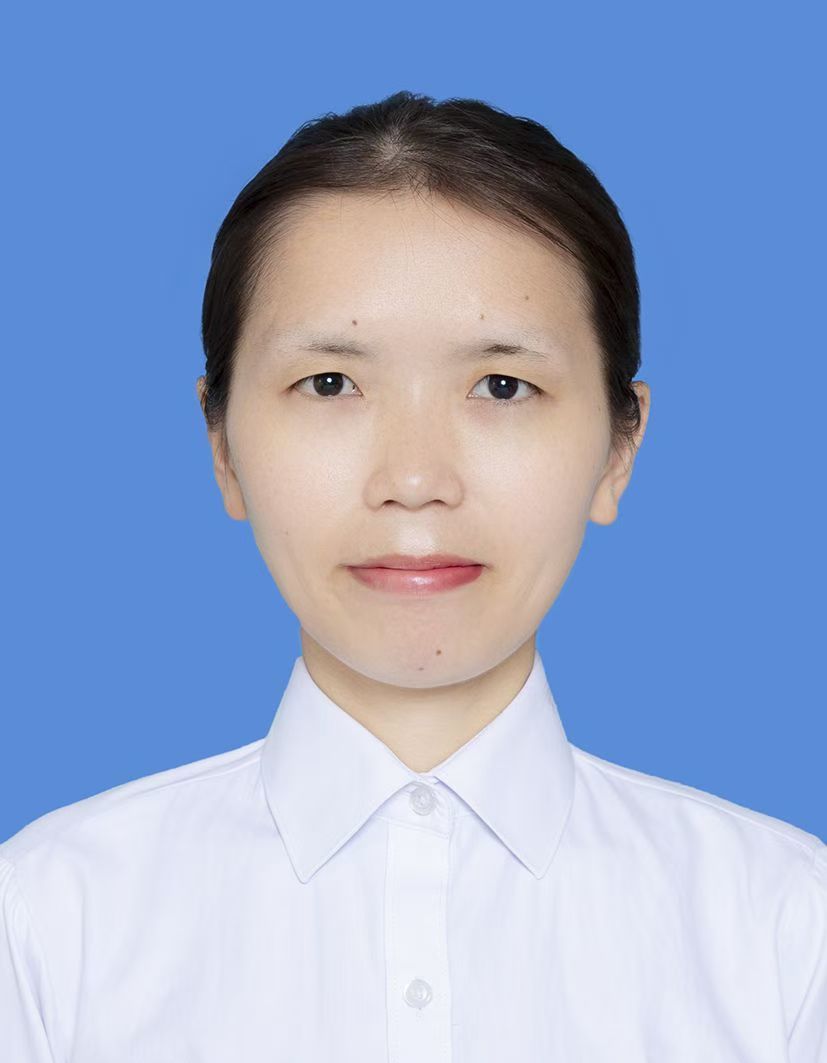- Présentation
- Personnel
- Publications
- Séminaires
- Financement
- Collaborations
- Actualité
- Brevets
- Liens utiles
2025
Advanced delivery systems for gene editing: A comprehensive review from the GenE-HumDi COST Action Working Group
Alessia Cavazza, Francisco J Molina-Estévez, Álvaro Plaza Reyes, Victor Ronco, Asma Naseem, Špela Malenšek, Peter Pečan, Annalisa Santini, Paula Heredia, Araceli Aguilar-González, Houria Boulaiz, Qianqian Ni, Marina Cortijo-Gutierrez, Kristina Pavlovic, Inmaculada Herrera, Berta de la Cerda, Emilio M Garcia-Tenorio, Eva Richard, Sergio Granados-Principal, Arístides López-Márquez, Mariana Köber, Marijana Stojanovic, Melita Vidaković, Irene Santos-Garcia, Lorea Blázquez, Emily Haughton, Dongnan Yan, Rosario María Sánchez-Martín, Loubna Mazini, Gloria Gonzalez Aseguinolaza, Annarita Miccio, Paula Rio, Lourdes R Desviat, Manuel a F V Gonçalves, Ling Peng, Cecilia Jiménez-Mallebrera, Francisco Martin Molina, Dhanu Gupta, Duško Lainšček, Yonglun Luo, Karim Benabdellah
Molecular Therapy - Nucleic Acids 36:102457 (2025)10.1016/j.omtn.2025.102457
Amphiphilic dendrimer-assisted delivery of antisense nucleic acid mimics against E. coli
Mariana Gomes, Igor Resende, Yana Zamoshchak, Daniela Araújo, Joana Castro, Dinesh Dhumal, Ling Peng, Rita S Santos, Nuno F Azevedo
Journal of Controlled Release 384:113850 (2025)10.1016/j.jconrel.2025.113850
Self-assembling dendrimer nanodrug formulations for decreased hERG-related toxicity and enhanced therapeutic efficacy
Xi Liu, Dinesh Dhumal, Patricia Santofimia-Castaño, Juan Liu, Marion Casanova, Alicia Comino Garcia-Muñoz, Teodora-Adriana Perles-Barbacaru, Abdechakour Elkihel, Wenzheng Zhang, Tom Roussel, Christina Galanakou, Jing Wu, Eleni Zerva, Nelson Dusetti, Yi Xia, Xing-Jie Liang, Angèle Viola, Juan Iovanna, Ling Peng
Science Advances 11 (2025)10.1126/sciadv.adu9948
P-cadherin mechanoactivates tumor-mesothelium metabolic coupling to promote ovarian cancer metastasis
Jing Ma, Sally Kit Yan To, Katie Sze Wai Fung, Kun Wang, Jiangwen Zhang, Alfonso Hing Wan Ngan, Susan Yung, Tak Mao Chan, Carmen Chak Lui Wong, Philip Pun Ching Ip, Ling Peng, Hong-Yan Guo, Chi Bun Chan, Alice Sze Tsai Wong
Cell Reports 44:115096 (2025)10.1016/j.celrep.2024.115096
Impact of inner hydrophobicity of dendrimer nanomicelles on biodistribution: a PET imaging study
Tom Roussel, Twiany Cruz-Dubois, Beatrice Louis, Erik Laurini, Ling Ding, Laure Balasse, Vincent Nail, Françoise Dignat‐george, Suzanne Giorgio, Sabrina Pricl, Benjamin Guillet, Philippe Garrigue, Ling Peng
Journal of materials chemistry B 13 (2025)10.1039/D4TB01266F
Bola-Amphiphilic Dendrimer Enhances Imatinib to Target Metastatic Ovarian Cancer via β-Catenin-HRP2 Signaling Axis
Zeyu Shi, Margarita Artemenko, Weiyu Yu, Ming Zhang, Canhui Yi, Peng Chen, Shuting Lin, Zhancun Bian, Baoping Lian, Fanzhen Meng, Jiaxuan Chen, Tom Roussel, Ying Li, Karen K L Chan, Philip P C Ip, Hung-Cheng Lai, Sally K Y To, Xiaoxuan Liu, Ling Peng, Alice S T Wong
ACS Applied Materials & Interfaces (2025)10.1021/acsami.4c12857
STING‐Activating Polymers Boost Lymphatic Delivery of mRNA Vaccine to Potentiate Cancer Immunotherapy
Miao Zhang, Yongling Wang, Benhao Li, Bowei Yang, Mengyao Zhao, Bingyu Li, Jianping Liu, Yaxin Hu, Zhaoming Wu, Yenhui Ong, Xiaolin Han, Lingwen Ding, Kongfu Zhu, Jianwei Li, Min Luo, Shengqi Chen, Ling Peng, Longjiang Zhang, Xiaoyuan Chen, Qianqian Ni
Advanced Materials (2025)10.1002/adma.202412654
2024
Amphiphilic Dendrimer as Potent Antibacterial against Drug-Resistant Bacteria in Mouse Models of Human Infectious Diseases
Noah King, Dinesh Dhumal, Shi Qian Lew, Shanny Hsuan Kuo, Christina Galanakou, Myung Whan Oh, Sook Yin Chong, Nian Zhang, Leo Tsz On Lee, Zvi Hayouka, Ling Peng, Gee W Lau
ACS Infectious Diseases 10:453-466 (2024)10.1021/acsinfecdis.3c00425
Development of an efficient NUPR1 inhibitor with anticancer activity
Xi Liu, Ana Jimenez-Alesanco, Zexian Li, Bruno Rizzuti, José L Neira, Matías Estaras, Ling Peng, Eduardo Chuluyan, Juan Garona, Florencia Gottardo, Adrián Velazquez-Campoy, Yi Xia, Olga Abian, Patricia Santofimia-Castaño, Juan Iovanna
Scientific Reports 14:29515 (2024)10.1038/s41598-024-79340-z
Self-assembling dendrimer nanosystems for specific fluorine magnetic resonance imaging and effective theranostic treatment of tumors
Zhenbin Lyu, Brigino Ralahy, Teodora-Adriana Perles-Barbacaru, Ling Ding, Yifan Jiang, Baoping Lian, Tom Roussel, Xi Liu, Christina Galanakou, Erik Laurini, Aura Tintaru, Suzanne Giorgio, Sabrina Pricl, Xiaoxuan Liu, Monique Bernard, Juan Iovanna, Angèle Viola, Ling Peng
Proceedings of the National Academy of Sciences of the United States of America 121:e2322403121 (2024)10.1073/pnas.2322403121
Insight into the Internal Structure of High-Performance Multicore Magnetic Nanoparticles Used in Cancer Thermotherapy
Tom Roussel, Daniel Ferry, Artemis Kosta, Dalila Miele, Giuseppina Sandri, Felista Tansi-Lemnyui, Frank Steiniger, Paul Southern, Quentin Pankhurst, Ling Peng, Suzanne Giorgio
ACS Materials Au (2024)
The synergistic neurovascular electro-healing of infected diabetic wounds by a multifaceted absorbable ion-conductive adhesive patch
Wenlong Wei, Jiayi Zheng, Ziru Liu, Ziqiu Li, Xiangyu Chen, Wenyue Yang, Pier-Luc Tremblay, Ling Peng, Tian Zhang
Chemical Engineering Journal 500:156387 (2024)10.1016/j.cej.2024.156387
Targeting the phosphatidylglycerol lipid: An amphiphilic dendrimer as a promising antibacterial candidate
Nian Zhang, Dinesh Dhumal, Shanny Hsuan Kuo, Shi Qian Lew, Pankaj Patil, Raleb Taher, Sanika Vaidya, Christina Galanakou, Abdechakour Elkihel, Myung Whan Oh, Sook Yin Chong, Domenico Marson, Jun Zheng, Oleg Rouvinski, Williams Abolarin, Sabrina Pricl, Gee Lau, Leo Tsz On Lee, Ling Peng
Science Advances 10:eadn8117 (2024)10.1126/sciadv.adn8117
Capture and flocculation of toxic cyanobacteria by amphiphilic peptide dendrimers for mitigating harmful blooms
Heng Zheng, Pier-Luc Tremblay, Wang Chen, Qi Wang, Danni Hu, Yuanzheng Huang, Xiaoxuan Liu, Cheng-Cai Zhang, Ling Peng, Tian Zhang
Chemical Engineering Journal (2024)10.1016/j.cej.2024.151382
2023
Progress and Harmonization of Gene Editing to Treat Human Diseases (Proceeding of COST Action CA21113 GenE-HumDi)
Alessia Cavazza, Ayal Hendel, Rasmus O Bak, Paula Rio, Marc Güell, Duško Lainšček, Virginia Arechavala-Gomeza, Ling Peng, Fatma Zehra Hapil, Joshua Harvey, Francisco G Ortega, Coral Gonzalez-Martinez, Carsten W Lederer, Kasper Mikkelsen, Giedrius Gasiunas, Nechama Kalter, Manuel a F V Gonçalves, Julie Petersen, Alejandro Garanto, Lluis Montoliu, Marcello Maresca, Stefan E Seemann, Jan Gorodkin, Loubna Mazini, Rosario Sanchez, Juan R Rodriguez-Madoz, Noelia Maldonado-Pérez, Torella Laura, Michael Schmueck-Henneresse, Cristina Maccalli, Julian Grünewald, Gloria Carmona, Neli Kachamakova-Trojanowska, Annarita Miccio, Francisco Martin, Giandomenico Turchiano, Toni Cathomen, Yonglun Luo, Shengdar Q Tsai, Karim Benabdellah
Molecular Therapy - Nucleic Acids (2023)10.1016/j.omtn.2023.102066
Cargo-selective and adaptive delivery of nucleic acid therapeutics by bola-amphiphilic dendrimers
Jiaxuan Chen, Dandan Zhu, Baoping Lian, Kangjie Shi, Peng Chen, Ying Li, Wenyi Lin, Ling Ding, Qiulin Long, Yang Wang, Erik Laurini, Wenjun Lan, Yun Li, Aura Tintaru, Caoyun Ju, Can Zhang, Sabrina Pricl, Juan Iovanna, Xiaoxuan Liu, Ling Peng
Proceedings of the National Academy of Sciences of the United States of America 120:e2220787120 (2023)10.1073/pnas.2220787120
Modular Self‐Assembling Dendrimer Nanosystems for Magnetic Resonance And Multimodality Imaging of Tumors
Ling Ding, Zhenbin Lyu, Teodora‐adriana Perles-Barbacaru, Adela Ya‐ting Huang, Baoping Lian, Yifan Jiang, Tom Roussel, Christina Galanakou, Suzanne Giorgio, Chai‐lin Kao, Xiaoxuan Liu, Juan Iovanna, Monique Bernard, Angèle Viola, Ling Peng
Advanced Materials (2023)10.1002/adma.202308262
Amphiphilic dendrimers against antibiotic resistance: light at the end of the tunnel?
Christina Galanakou, Dinesh Dhumal, Ling Peng
Biomaterials Science (2023)10.1039/D2BM01878K
Dendrimer nanosystems for adaptive tumor-assisted drug delivery via extracellular vesicle hijacking
Yifan Jiang, Zhenbin Lyu, Brigino Ralahy, Juan Liu, Tom Roussel, Ling Ding, Jingjie Tang, Artemis Kosta, Suzanne Giorgio, Richard Tomasini, Xing-Jie Liang, Nelson Dusetti, Juan Iovanna, Ling Peng
Proceedings of the National Academy of Sciences of the United States of America 120 (2023)10.1073/pnas.2215308120
Amphiphilic Dendrimer Doping Enhanced pH-Sensitivity of Liposomal Vesicle for Effective Co-delivery Toward Synergistic Ferroptosis-Apoptosis Therapy of Hepatocellular Carcinoma
Yanhong Su, Zhao Zhang, Leo Tsz, Ling Peng, Ligong Lu, Xu He, Xuanjun Zhang
Advanced Healthcare Materials 12:2202663 (2023)10.1002/adhm.202202663
A PD‐L1 Antibody‐Conjugated PAMAM Dendrimer Nanosystem for Simultaneously Inhibiting Glycolysis and Promoting Immune Response in Fighting Breast Cancer
Peng Zhang, Zhi Li, Weiling Cao, Jingjie Tang, Yi Xia, Ling Peng, Jing Ma
Advanced Materials (2023)10.1002/adma.202305215
2022
Amphiphilic Dendrimer Vectors for RNA Delivery: State-of-the-Art and Future Perspective
Jiaxuan Chen, Dandan Zhu, Xiaoxuan Liu, Ling Peng
Accounts of Materials Research (2022)10.1021/accountsmr.1c00272
Dynamic self-assembling supramolecular dendrimer nanosystems as potent antibacterial candidates against drug-resistant bacteria and biofilms
Dinesh Dhumal, Bar Maron, Einav Malach, Zhenbin Lyu, Ling Ding, Domenico Marson, Erik Laurini, Aura Tintaru, Brigino Ralahy, Suzanne Giorgio, Sabrina Pricl, Zvi Hayouka, Ling Peng
Nanoscale (2022)10.1039/d2nr02305a
Thermostable ionizable lipid-like nanoparticle (iLAND) for RNAi treatment of hyperlipidemia
Bo Hu, Bo Li, Kun Li, Yuanyuan Liu, Chunhui Li, Lulu Zheng, Mengjie Zhang, Tongren Yang, Shuai Guo, Xiyu Dong, Tian Zhang, Qing Liu, Abid Hussain, Yuhua Weng, Ling Peng, Yongxiang Zhao, Xing-Jie Liang, Yuanyu Huang
Science Advances 8 (2022)10.1126/sciadv.abm1418
Solid-phase dendrimer synthesis: a promising approach to transform dendrimer construction
Ya-Ting Huang, C.-L Kao, A Selvaraj, Ling Peng
Materials Today Chemistry (2022)10.1016/j.mtchem.2022.101285
A biodegradable amphiphilic poly(aminoester) dendrimer for safe and effective siRNA delivery
Chi Ma, Dandan Zhu, Wenyi Lin, Ying Li, Yuanzheng Huang, Huiling Zhu, Mengyun Ye, Yang Wang, Ling Peng, Xiaoxuan Liu
Chemical Communications (2022)10.1039/D1CC06655B
NUPR1 protects against hyperPARylation-dependent cell death
Patricia Santofimia-Castano, Can Huang, Xi Liu, Yi Xia, Stephane Audebert, Luc Camoin, Ling Peng, Gwen Lomberk, Raul Urrutia, Philippe Soubeyran, Jose Luis Neira, Juan Iovanna
Communications Biology 5 (2022)10.1038/s42003-022-03705-1
Small Activating RNA Modulation of the G Protein‐Coupled Receptor for Cancer Treatment
Yunfang Xiong, Ran Ke, Qingyu Zhang, Wenjun Lan, Wanjun Yuan, Karol Nga Ieng Chan, Tom Roussel, Yifan Jiang, Jing Wu, Shuai Liu, Alice Sze Tsai Wong, Joong Sup Shim, Xuanjun Zhang, Ruiyu Xie, Nelson Dusetti, Juan Iovanna, Nagy Habib, Ling Peng, Leo Tsz On Lee
Advanced Science 2200562 (2022)10.1002/advs.202200562
Bola‐Amphiphilic Glycodendrimers: New Carbohydrate Mimicking Scaffolds to Target Carbohydrate‐Binding Proteins
Wenzheng Zhang, Dinesh Dhumal, Xiaolei Zhu, Brigino Ralahy, Aleksandra Ellert-Miklaszewska, Jing Wu, Erik Laurini, Yi-Wen W Yao, Chai-Lin L Kao, Juan L Iovanna, Sabrina Pricl, Bozena Kaminska, Yi Xia, Ling Peng
Chemistry - A European Journal (2022)10.1002/chem.202201400
2021
An ionizable supramolecular dendrimer nanosystem for effective siRNA delivery with a favorable safety profile
Dinesh Dhumal, Wenjun Lan, Ling Ding, Yifan Jiang, Zhenbin Lyu, Erik Laurini, Domenico Marson, Aura Tintaru, Nelson Dusetti, Suzanne Giorgio, Juan Lucio Iovanna, Sabrina Pricl, Ling Peng
Nano Research (2021)10.1007/s12274-020-3216-8
Webinar at 10h30 (CET) on Monday 17/01/2022
Small activating RNA therapeutics from concept to Phase 2 clinical trials
Prof. Nagy Habib
Imperial College of London, UK
Zoom Meeting linker :
https://univ-amu-fr.zoom.us/j/92847760892?pwd=eTZtbllYMVltZHRpV2JKdEZVVkxKdz09
Abstract:
Small activating RNA (saRNA) molecules are double stranded 21 nucleotide RNA that either target promoters or enhance genes leading to mRNA upregulation. saRNAs can be delivered with liposomes into the systemic circulation or subcutaneously by conjugation with aptamers or GalNAC. MTL-CEBPA is an investigative drug that resulted from the conjugation of saRNA CEBPA with NOV 340 lipsomes that targets tumour associated macrophages in order to alter favourably the tumour microenvironment. MTL-CEBPA has been administered safely in over 100 patients with advanced cancer and improved clinical outcome in a sub-set of patients when co-administered with TKI or check point inhibitor.
Reference:
https://clincancerres.aacrjournals.org/content/early/2021/08/24/1078-0432.CCR-21-0986.long
Biograph
Nagy is Lead Clinician and Head of the Department of HPB Surgery at Imperial College London. Nagy is also the founder and Head of R&D of MiNA Therapeutics. For over three decades Nagy has been at the forefront of clinical research and clinical practice in cancer. He pioneered the first clinical trial in the use of adenovirus and plasmid for the treatment of liver cancer, as well as the use of plasmid gene therapy in hydrodynamic gene delivery. Currently, he is driving the development of an saRNA drug (a new class of medicines) which is currently being trialed in patients with liver cancer in eight UK centres, and sites in Singapore and Taiwan (OUTREACH study, ClinicalTrials.gov ID NCT02716012) and in a second trial in patients with solid tumours (TIMEPOINT study, ClinicalTrials.gov ID NCT 04105335) in the UK, USA, Europe, Singapore and Taiwan. He has published widely in gene therapy, stem cell therapy, oligonucleotides, endoscopy and surgery. Previously Nagy was founder and Chairman of EMcision Limited (acquired by Boston Scientific Inc in 2018).
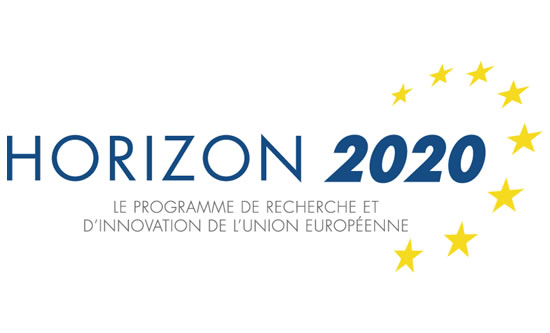
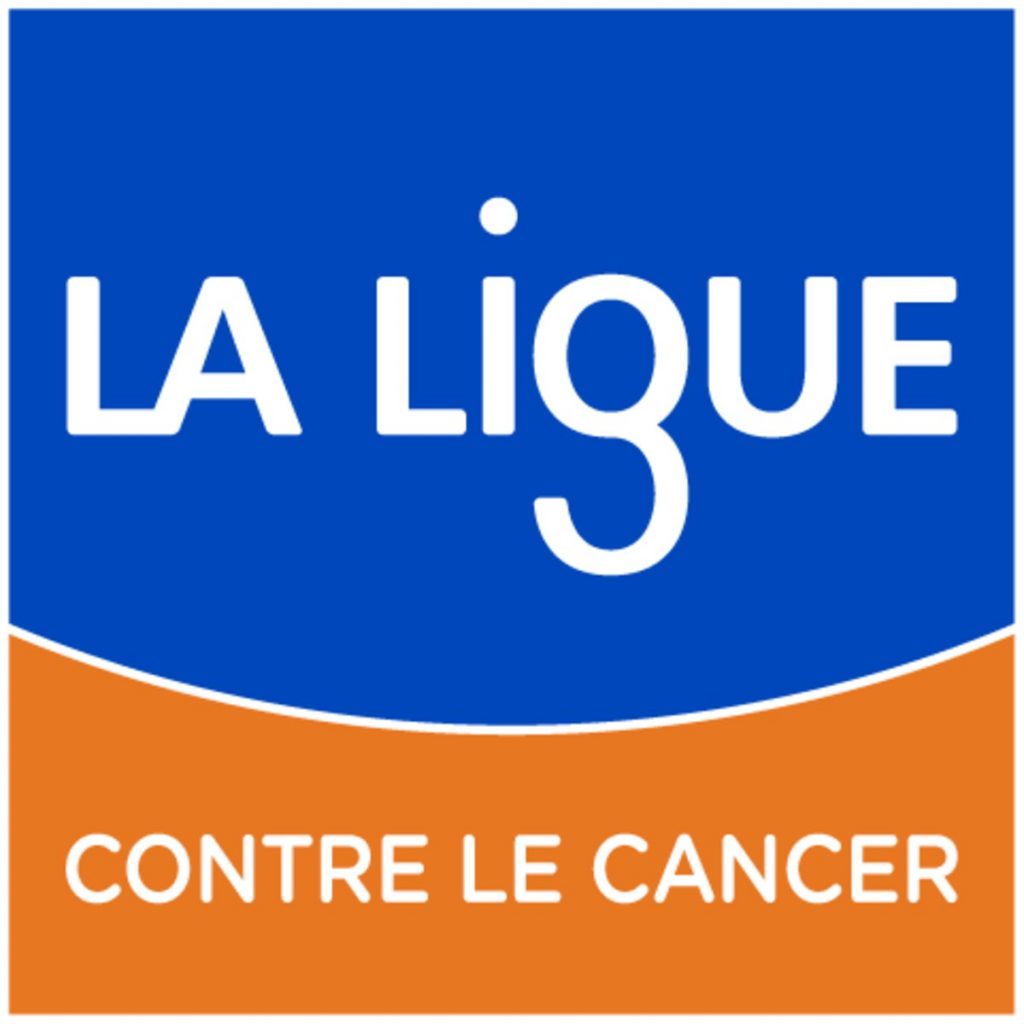
-
EU Horizon Europe Research and Innovation program Cancer Mission “HIT-GLIO” (2023-2027) (grant agreement No. 101136835)
Link: https://hit-glio.eu/
-
EU H2020 ERA-NET EuroNanoMed III project "antineuropatho"
2022-2025: "Developing Novel nanopharmaceutics against bacterial infections at center nervous system"
-
EU H2020 ERA-NET EuroNanoMed III project "iNanoGun"
2021-2023: “Reactivation of antitumor immune responses in gliomas using nanotechnology based targeted delivery”
-
EU H2020 Marie-Curie ITN project "OLIGOMED"
2021-2024: “Oligonucleotides for Medical Applications”
-
Equipe Labellisée Ligue Nationale Contre le Cancer,
2021-2023: “Modular nanosystems for multimodal imaging and theranostics to fight against cancer”
-
Equipe Labellisé par La Ligue
2016-2020: “Innovative dendrimer nanotechnology based theranostics for cancer therapy”
-
ERA-Net EuroNanoMed project “Target4Cancer”
2016-2019: “(Nano)systems with active targeting to sensitize colorectal cancer stem cells to anti-tumoral treatment”
-
ERA-Net EuroNanoMed project “NANOGLIO”
2017-2020: “Nanotechnology based immunotherapy for glioblastoma”
-
ERA-Net EuroNanoMed III project “TARBRAINFECT”
2019-2022: "Nanosystems conjugated with antibody fragments for treating brain infections"
-
EU H2020 NMBP project “SAFE-N-MEDTECH”
2019-2023: "Safety testing in the life cycle of nanotechnology-enabled medical technologies for health"
-
EU H2020 ERA-Net EuroNanoMed III project "NAN-4-TUM"
2020-2023 "development of CXCR4 targeting-nanosystem-imaging probes for molecular imaging of cancer cells and tumor microenvironment"
1) EU project "Safe-n-medtech": https://safenmt.eu
2) EU COST Action CA17140 "nano2clinic" : https://www.nano2clinic.eu/cost-action-ca17140
Dr. Monique Bernard (Aix-Marseille University, CRMBM, Marseille, France)
Prof. Benjamin Guillet (Aix-Marseille University, CERIMED, Marseille, France)
Prof. Yuanyu Huang (Beijing University of Technology, Beijing, China)
Dr. Juan Iovanna (INSERM CRCM, Marseille, France)
Prof. Chai-Lin Kao (Kaohsiung Medical University, Kaohsiung, Taiwan)
Prof. Bozena Kaminska (Nencki Institute of Experimental Biology, Warsaw, Poland)
Prof. Xiaoxuan Liu (China Pharmaceutical University, Nanjing, China)
Prof. Sabrina Pricl (Trieste University, Trieste, Italy)
Dr. Aura Tintaru (Aix-Marseille University, ICR, Marseille, France)
Prof. Alice Wong, (Hong Kong University, Hong Kong)
Prof. Yi Xia (Chongqing University, Chongqing, China)
- Mai 2023
Cargo-selective and adaptive delivery of nucleic acid therapeutics by bola-amphiphilic dendrimers
Jiaxuan Chen, Dandan Zhu, Baoping Lian, Kangjie Shi, Peng Chen, Ying Li, Wenyi Lin, Ling Ding, Qiulin Long, Yang Wang, Erik Laurini, Wenjun Lan, Yun Li, Aura Tintaru, Caoyun Ju, Can Zhang, Sabrina Pric, Juan Iovanna, Xiaoxuan Liu, Ling Peng
May 15, 2023, 120 (21) e2220787120
DOI: www.pnas.org/doi/10.1073/pnas.2220787120
Tailor-made functional materials that meet specific requirements for different applications are of great importance in material and biomedical research. Dendrimers, by virtue of their well-defined structure and cooperative multivalence, represent precision materials. Recently, we synthesized and studied bipolar (bola) amphiphilic dendrimers for selective and on-demand delivery of DNA and small interfering RNA (siRNA), both are important nucleic acid therapeutics (Figure 1). Nucleic acid therapeutics are becoming a new drug modality, offering the unique opportunity to target "undruggable" targets, respond rapidly to evolving pathogens, and treat diseases at the genetic level for precision medicine. However, nucleic acid therapeutics suffer from poor bioavailability and are susceptible to chemical and enzymatic degradation, necessitating the use of delivery vectors.
By employing bola-amphiphilic dendrimers, we achieved superior performance in siRNA delivery with the second-generation dendrimer, whereas the third-generation dendrimer showed excellent DNA delivery. We systematically investigated these dendrimers in terms of cargo binding, cellular uptake, endosomal release, and in vivo delivery. The differences in size between the dendrimers and their nucleic acid cargos affected the cooperative multivalent interactions for cargo/vector binding and release, resulting in adaptive and selective cargo delivery (Figure 2). Furthermore, both dendrimers capitalized on the advantages of lipid and polymer vectors, while also providing tumor-targeting capabilities based on nanotechnology and redox-responsive cargo release. Notably, they enabled tumor- and cancer cell-specific delivery of siRNA and DNA therapeutics, leading to effective treatment in various cancer models, including aggressive and metastatic malignancies. These dendrimers outperformed currently available vectors (Figure 3). This study will inspire further exploitation of tailor-made dendrimer platforms for the cargo-selective delivery of various therapeutics in precision medicine.
This collaborative study involved the Centre Interdisciplinaire de Nanoscience de Marseille (CINaM), China Pharmaceutical University, Trieste University and the Centre de Recherche en Cancérologie de Marseille (CRCM).
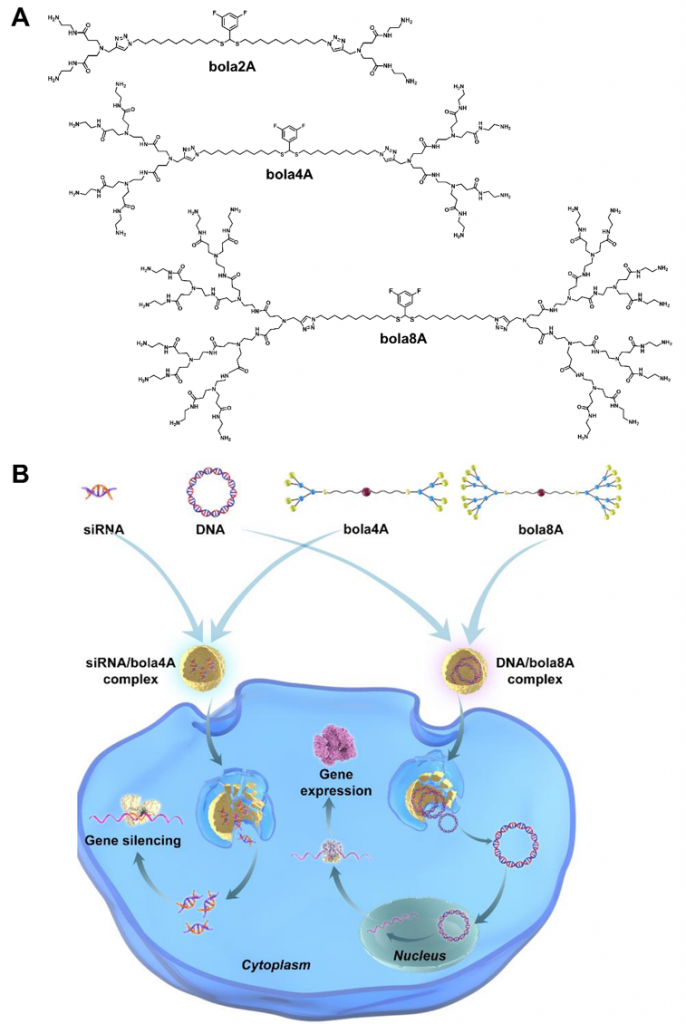
Fig. 1. Bola-amphiphilic dendrimers for cargo-specific nucleic acid delivery. (A) Chemical structures of the bola-amphiphilic dendrimers bola2A, bola4A, and bola8A studied in this work. (B) Cartoon illustration of bola-amphiphilic dendrimers bola4A and bola8A for cargo-selective and adaptive delivery of the two distinct nucleic acid types, DNA and siRNA.

Fig. 2. Physicochemical characterization of and rationale behind the cargo-selective delivery performance of bola4A and bola8A. (A) The sizes and the ζ-potentials of the DNA/dendrimer complex and the siRNA/dendrimer complex obtained with DNA (24 ng/μL) at an N/P ratio of 2 and siRNA (1.0 μM) at an N/P ratio of 10. (B, C) Cellular uptake and intracellular trafficking of DNA and siRNA delivered by the bola-amphiphilic dendrimers bola4A and bola8A. Confocal imaging of the cellular uptake of (B) the DNA/dendrimer complexes (12 ng/μL YOYO-1-labeled DNA, N/P ratio of 1.0) and (C) the siRNA/dendrimer complexes (50 nM Cy5-labeled siRNA, N/P ratio of 10) in SKOV-3 cells, evaluated using confocal microscopy. The green channel image shows the YOYO-1-labeled DNA (green), the red channel image shows the Cy5-labeled siRNA (red), and the blue channel image shows the nuclei of the SKOV-3 cells stained by Hoechst33342 (blue). (D) The siRNA release from the siRNA/dendrimer complexes assessed using heparin-coupled ethidium bromide (EB) fluorescence assays. ***p < 0.001 versus siRNA/bola4A or siRNA/bola8A, and significance was determined using two-way ANOVA (mean ± SD, n = 3). Atomistic MD simulations of bola4A and bola8A in the presence of siRNA (E and F) and DNA (G and H), respectively. Bola4A atoms are shown as “firebrick spheres”, with the terminal charged amine groups highlighted in deep sky-blue, while bola8A atoms are depicted as dark red spheres with the terminal charged amines colored in navy blue. The siRNA (“orchid” light purple) and the DNA (dark purple) are portrayed as their van der Waals surface and the oxygen atoms in water are shown as cyan transparent spheres. Hydrogen atoms, ions and counterions (Na+ and Cl-) are omitted for clarity. (I) Binding data of bola4A and bola8A with siRNA and DNA as derived from atomistic MD simulations: free energy of effective binding (ΔGbind,eff), number of effective charges (Neff), and effective-charge-normalized free energy of binding (ΔGbind,eff/Neff) for the nucleic acid/dendrimer complexes are listed.

Fig. 3. Effective inhibition of tumor metastasis using DNA and siRNA therapeutics delivered by bola8A and bola4A respectively in lung metastatic cancer model. (A-E) 4T1-luc metastatic tumor-bearing mice received intravenous injections of PBS buffer (control), p53 alone, p53/bola8A complex, p53/Lipo complex (2.0 mg/kg DNA, 1.5 mg/kg bola8A, N/P ratio of 1.0), siAKT2 alone, siAKT2/bola4A complex, or siAKT2/MC3 complex (1.0 mg/kg siRNA, 3.9 mg/kg bola4A, N/P ratio of 5.0) (n=5): (A) In vivo bioluminescence imaging of 4T1-luc tumor metastases in the mice. (B) Ex vivo bioluminescence imaging of 4T1-luc tumor metastases in the lung at the experimental end point post treatment. (C) Histological analysis of lung tissues from 4T1-luc metastatic tumor-bearing mice at the experimental end point post treatment. The metastatic lesions (red solid outlines) were identified as cell clusters with darkly stained nuclei. Scale bars, 1 m. (D) p53 and (E) AKT2 protein expression revealed by immunohistochemistry staining after treatments. Scale bar, 200 μm. (F-J) B16-F10-luc metastatic tumor-bearing mice received intravenous injections of PBS buffer (control), p53 alone, p53/bola8A complex, p53/JetPEI complex (2.0 mg/kg DNA, 1.5 mg/kg bola8A, N/P ratio of 1.0), siAKT2 alone, siAKT2/bola4A complex, or siAKT2/MC3 complex (1.0 mg/kg siRNA, 3.9 mg/kg bola4A, N/P ratio of 5.0) (n=5): (F) in vivo bioluminescence imaging of B16-F10-luc tumor metastases in the mice. (G) Ex vivo bioluminescence imaging of B16-F10-luc tumor metastases in the lung tissue or images of excised lung tissues at the experimental end point post treatment. (H) Histological analysis of lung tissues from B16-F10-luc metastatic tumor-bearing mice at the experimental end point post treatment. The metastatic lesions (red solid outline) were identified as cell clusters with darkly stained nuclei. Scale bars, 1.0 m. (I) p53 and (J) AKT2 protein expression revealed by immunohistochemistry staining after treatments. Scale bar, 200 μm. p53: plasmid DNA expressing tumor suppressor protein p53, siAKT2: siRNA targeting AKT2.
- Mai 2023
http://xlink.rsc.org/?DOI=D2BM01878K

- Février 2023:
Dendrimer nanosystems for adaptive tumor-assisted drug delivery via extracellular vesicle hijacking
Yifan Jiang, Zhenbin Lyu, Brigino Ralahy, Juan Liu, Tom Roussel, Ling Ding, Jingjie Tang, Artemis Kosta, Suzanne Giorgio, Richard Tomasini, Xing-Jie Liang, Nelson Dusetti, Juan Iovanna, Ling Peng
PNAS, 2023, Vol. 120, No. 7, e2215308120; https://doi.org/10.1073/pnas.2215308120
Cancer is one of the leading causes of death in the world, and remains a difficult disease to treat because of its intrinsic heterogeneity and dynamic evolution. Nanosystems (DDSs) that can overcome tumor heterogeneity and dynamic evolution, yet delivering anticancer drug deep in tumor tissue are desperately demanded for cancer treatment. However, such systems are difficult and challenging to develop. We report a drug delivery nanosystem based on self-assembling dendrimer nanomicelles (ADNMs) for deep tumor penetration and effective drug delivery via in situ tumor-secreted extracellular vesicles (EVs), an endogenous transport system that evolves with the parental cells in the tumor microenvironment, hence overcoming tumor heterogeneity and dynamic evolution, leading to excellent anticancer activity. Specifically, these dendrimer nanomicelles, upon arrival at a tumor, had their drug payload repackaged by the cells into EVs. Those were further transported and internalized by other cells for delivery “in relay”, deep into the tumor tissue improving drug delivery efficacy and cancer cell killing (Figure 1). Using pancreatic and colorectal cancer-derived 2D, 3D, and xenograft models, we demonstrated that the in situ-generated EVs mediated intercellular delivery (Figure 2), propagating drug delivery from cell to cell deep into the tumor, leading to excellent anticancer potency yet reducing adverse effects (Figure 3). These promising results highlight the remarkable potential of this drug delivery system for cancer treatment and provide a proof of concept for the development of new therapeutic modalities for adaptive drug delivery. This study also provides a new perspective on exploiting the intrinsic features of tumor alongside dendrimer supramolecular chemistry to develop smart and effective DDSs to overcome intra-tumoral microenvironment and heterogeneity as their evolutive nature, thereby improving cancer therapy.
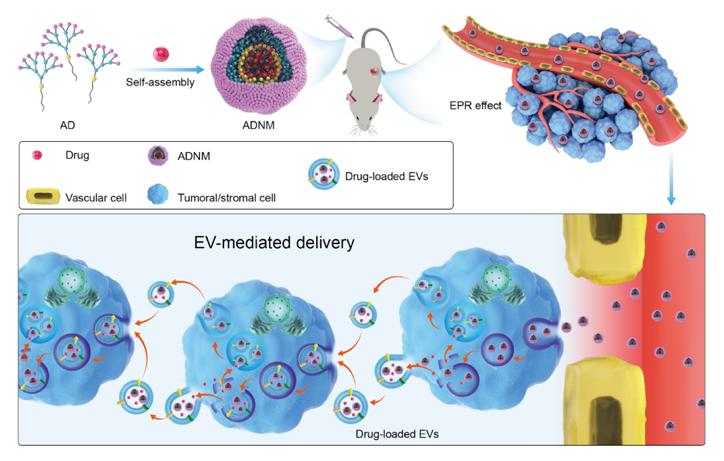
Figure 1: Amphiphilic dendrimer nanomicelles (ADNMs) encapsulate the anticancer drug and induce tumor-assisted drug delivery via extracellular vesicle (EV)-mediated intercellular transport. The amphiphilic dendrimer (AD) encapsulates the anticancer drug and forms nanomicelles (ADNMs) which reach the tumor lesion via the enhanced permeability and retention (EPR) effect. There they induce in situ tumor-assisted drug delivery for deep tumor penetration via EV-mediated intercellular transport. This EV-mediated delivery process involves: (1) internalization of ADNMs inside cells within the tumor tissue; (2) repackaging of ADNM payload into EVs; (3) intercellular transport of the generated EVs; (4) internalization of the generated EVs by the recipient cell.
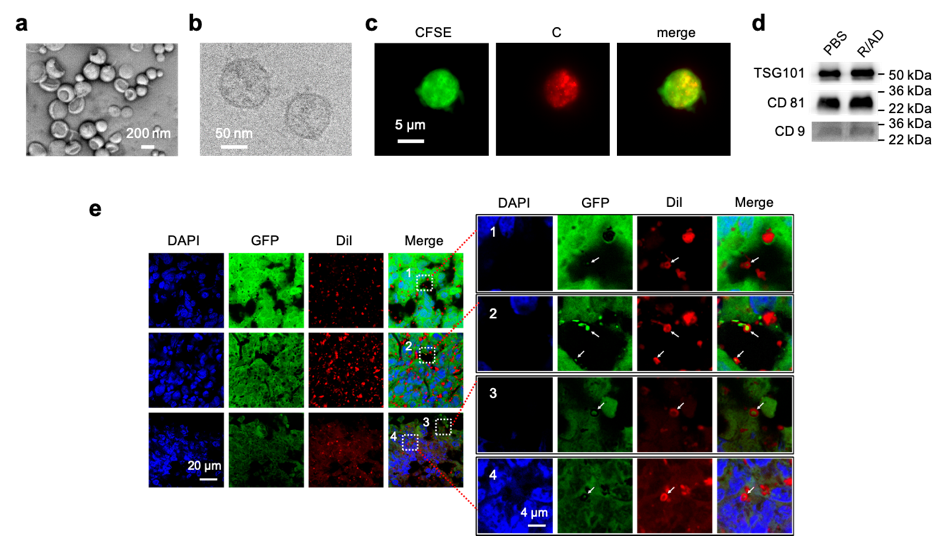
Figure 2. ADNM induced EV payload-packaging and cellular uptake. EVs, generated by cells upon treatment with ADNMs (R/AD, Cy3/R/AD and Dil/R/AD), were characterized using TEM (a), cryogenic electron microscopy (Cryo-EM) (b), fluorescent microscopy (c) and EV using western blotting (d). e, Confocal images of cryo-sectioned tumor tissues from HCT-8GFP xenograft mice treated with ADNM (DiI/R/AD) show the process of EV-mediated delivery in the tumor. The DiI fluorescence appeared in EVs derived from HCT-8GFP tumor (arrows). The hollow-donut shape of red DiI signal with green GFP filling highlights the HCT-8GFP-derived EVs with the DiI-labelled phospholipid bilayer and the HCT-8GFP-derived contents inside. Box 1, a DiI-loaded EV (arrow) located within the intercellular space; Box 2–4, the DiI-loaded EVs mediated intercellular transport within the tumor. Box 2, DiI-loaded EVs adhered onto the cell surface; Box 3, a DiI-loaded EV entering into a cell; Box 4, a DiI-loaded EV inside a cell. The tumor tissues were collected 24 hours after intravenous injection of DiI/R/AD in HCT-8GFP xenografts. AD: amphiphilic dendrimer; C: Cy3; Dil: fluorescent dye; R: rapamycin.
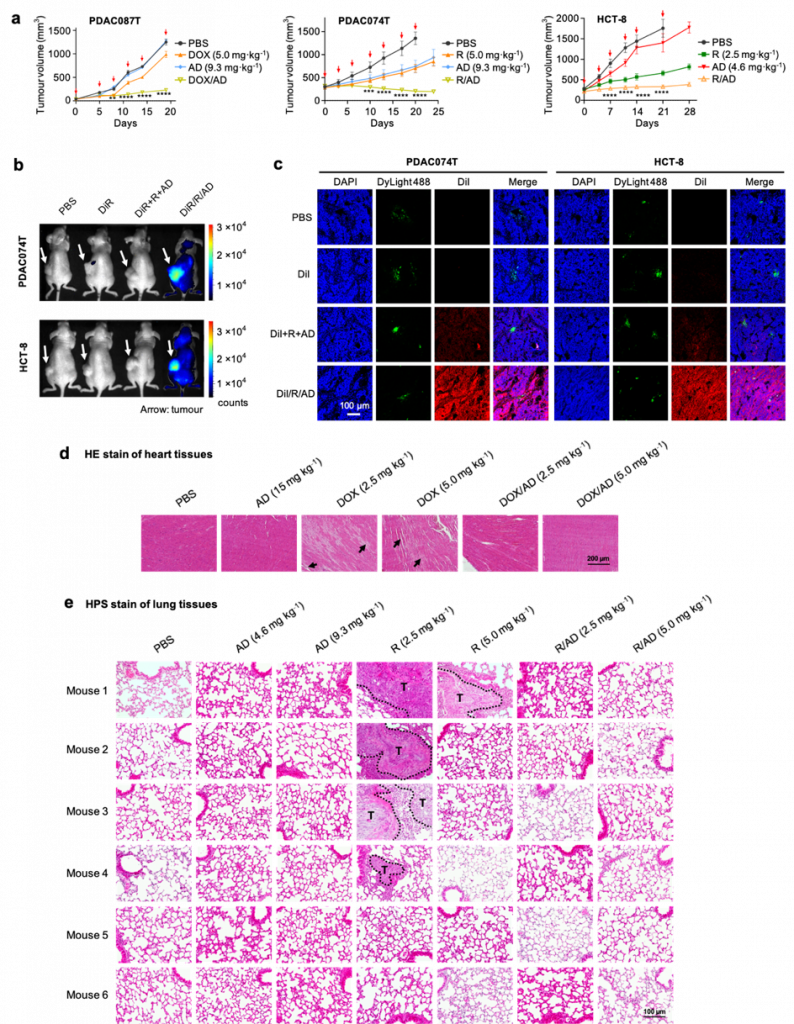
Figure 3. ADNMs were effective for inhibiting tumor growth, reducing drug toxicity and preventing tumor metastasis via specific accumulation and deep penetration through EVs in tumor. a, Tumor growth curves of the patient-derived pancreatic cancer xenografts PDAC087T and PDAC074T, and the colorectal cancer HCT-8 xenografts in mice upon treatment with ADNM carrying either doxorubicin (DOX) or rapamycin R, respectively. Mice treated with PBS buffer, drug alone or dendrimer alone were used as the controls. Data are presented as the mean ± s.e.m. The statistical significance was calculated by two-way ANOVA with a Tukey's multiple comparisons test. n = 6 mice for all groups. *P < 0.05, **P < 0.01, ***P < 0.001, ****P < 0.0001. b, Accumulation of R/AD in tumors in the PDAC074T and HCT-8 xenograft mice was analyzed using fluorescent imaging with ADNM carrying both rapamycin and the near-infrared fluorescent dye DiR (DiR/R/AD). The in vivo fluorescence images were acquired 48 hours after intravenous administration of DiR/R/AD in PDAC074T (upper panel) and HCT-8 (lower panel) xenografts. Mice treated with PBS, free DiR, and a simple mixture of DiR, rapamycin and AD (DiR+R+AD), were used as controls. Arrows point to the tumor locations. c, Confocal images of tumor tissues show a deep intratumoral penetration of R/AD, using ADNM loaded with both rapamycin and the fluorescent dye DiI (DiI/R/AD). Mice treated with PBS, DiI alone, or a simple mixture of DiI, rapamycin and AD (DiI+R+AD), were used as controls. Tumors were harvested from PDAC074T (left) and HCT-8 (right) xenografts 24 hours post-intravenous administration, then cryosectioned and imaged by tracing DiI fluorescence (red). Blood vessels were labelled with DyLight488-labelled Lycopersicon esculentum lectin (green), and nuclei with DAPI (blue). d, HE stain of heart tissue issued from PDAC087T xenografts treated with PBS, AD, DOX and DOX/AD (n = 6). Treatment with DOX/AD prevented DOX-induced hyperemia and myocardial fiber breakage (arrows) in heart. e, HPS stain of lung tissues issued from HCT-8 xenografts treated with PBS, AD, R and R/AD (n = 6). Treatment with R/AD prevented the rapamycin-induced lung metastasis (T represents the tumor). Lung metastases were observed in mice treated with R, but not in those treated with PBS, dendrimer alone (AD) or the R/AD. Lung tissue was collected from mice at the end of treatment.
- Aout 2022: 3 nouveaux articles publiés par notre groupe
-
- Dynamic self-assembling supramolecular dendrimer nanosystems as potent antibacterial candidates against drug-resistant bacteria and biofilms
Dinesh Dhumal, Bar Maron, Einav Malach, Zhenbin Lyu, Ling Ding, Domenico Marson, Erik Laurini, Aura Tintaru, Brigino Ralahy, Suzanne Giorgio, Sabrina Pricl, Zvi Hayouka and Ling Peng
Nanoscale, 2022, 14, 9286-9296. DOI:10.1039/d2nr02305a
The alarming and prevailing antibiotic resistance crisis urgently calls for innovative “outside of the box” antibacterial agents, which will differ substantially from conventional antibiotics. In this context, we have established antibacterial candidates based on dynamic supramolecular dendrimer nanosystems self-assembled with amphiphilic dendrimers composed of a long hydrophobic alkyl chain and a small hydrophilic poly(amidoamine) dendron bearing distinct terminal functionalities. Remarkably, the amphiphilic dendrimer with amine terminals exhibited strong antibacterial activity against both Gram-positive and Gram-negative as well as drug-resistant bacteria, and prevented biofilm formation. Multidisciplinary studies combining experimental approaches and computer modelling together demonstrate that the dendrimer interacts and binds via electrostatic interactions with the bacterial membrane, where it becomes enriched and then dynamically self-assembles into supramolecular nanoassemblies for stronger and multivalent interactions. These, in turn, rapidly promote the insertion of the hydrophobic dendrimer tail into the bacterial membrane thereby inducing bacterial cell lysis and constituting powerful antibacterial activity. Our study presents a novel concept for creating nanotechnology-based antibacterial candidates via dynamic self-assembly and offers a new perspective for combatting recalcitrant bacterial infection.
This is a collaborative study among Centre Interdisciplinaire de Nanoscience de Marseille (CINaM) at Aix-Marseille University in France, The Hebrew University of Jerusalem in Israel, and University of Trieste in Italy.

Figure: Amphiphilic dendrimers studied for antibacterial activity in this work. (A) Chemical structures of amphiphilic PAMAM dendrimers 1a–d bearing different terminal groups; (B) Cartoon illustration of the antibacterial activity shown by these amphiphilic dendrimers via membrane adsorption, self-assembling, interaction, insertion, disintegration and disruption.
-
- Bola-Amphiphilic Glycodendrimers: New Carbohydrate Mimicking Scaffolds to Target Carbohydrate-Binding Proteins
Wenzheng Zhang, Dinesh Dhumal, Xiaolei Zhu, Brigino Ralahy, Aleksandra Ellert- Miklaszewska, Jing Wu, Erik Laurini, Yi-Wen Yao, Chai-Lin Kao, Juan L. Iovanna, Sabrina Pricl, Bozena Kaminska, Yi Xia* and Ling Peng*
Chemistry – A European Journal, DOI: 10.1002/chem.202201400
Carbohydrates, the most abundant biomacromolecules, are important not only for energy production, but also as structural materials and as signaling moieties. They regulate many biological processes, such as cell differentiation, proliferation and adhesion, inflammation, cancer metastasis and immune responses etc. Carbohydrates mediate cell-cell and cell-matrix interactions via carbohydrate-carbohydrate and carbohydrate-protein binding by harnessing the glycoside cluster effect, which exploits the cooperative interactions issued from the branched and multivalent structure of carbohydrates for improved binding strength and specificity.
Dendrimers, by virtue of their unique ramified structure and multivalent cooperativity, are particularly appealing scaffolds for constructing carbohydrate mimics and targeting carbohydrate-binding proteins. In this study, we report novel bola-amphiphilic dendrimers bearing carbohydrate units for binding and targeting carbohydrate-binding proteins. Different from traditional amphiphilic molecules, the dumbbell-like shape of bola-amphiphiles has a unique bipolar amphiphilic structure, which is able to reinforce molecular recognition, binding and stability towards carbohydrate-binding proteins. In addition, the mannose- and glucose-terminated bola-amphiphilic dendrimers are able to target respectively mannose receptors and glucose transporters expressed on cell surface for effective and specific cellular uptake, hence holding great promise for targeted delivery.
This is a collaborative study among Aix-Marseille University in France, Chongqing University in China, Nencki Institute of Experimental Biology of the Polish Academy of Sciences in Poland and University of Trieste in Italy.
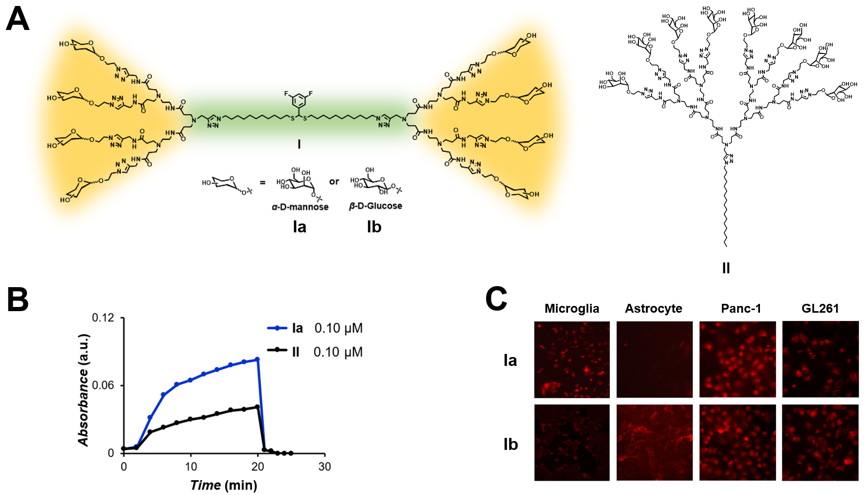
Figure 1. (A) Chemical structures of bola-amphiphilic glycodendrimers bearing mannose (Ia) and glucose (Ib) terminals studied in this work, with the amphiphilic dendrimer II bearing mannose terminals as the reference dendrimer; (B) Binding of Ia and II towards ConA using turbidimetric assay. Turbidity curves recorded at 450 nm for the precipitation of ConA with Ia and II, respectively, at 0.10 μM, in HEPES buffer at room temperature. (C) Imaging on the cellular uptake of fluorescent probe-labelled glycodendrimers Ia and Ib in primary microglia cultures, primary astrocyte cultures, human pancreatic cancer Panc-1 cells and mouse glioblastoma GL261 cells.
-
- Small Activating RNA Modulation of the G Protein-Coupled Receptor for Cancer TreatmentYunfang Xiong, Ran Ke, Qingyu Zhang, Wenjun Lan, Wanjun Yuan, Karol Nga Ieng Chan, Tom Roussel, Yifan Jiang, Jing Wu, Shuai Liu, Alice Sze Tsai Wong, Joong Sup Shim, Xuanjun Zhang, Ruiyu Xie, Nelson Dusetti, Juan Iovanna, Nagy Habib, Ling Peng*, Leo Tsz On Lee*
Advanced Science, DOI: 10.1002/advs.202200562
G protein-coupled receptors (GPCRs) are the most common and important drug targets, and more than 30% of approved drugs target GPCRs. However, over 70% of GPCRs are undruggable or difficult to target using conventional small molecular agonists/antagonists, because of the various subtypes and splice variants as well as the high similarity of GPCRs within the same subfamily and target selectivity. Therefore, a new strategy is urgently needed to develop effective and specific drug candidates to expand the druggable “GPCRome”.
Small nucleic acid molecules, which can sequence-specifically modulate any gene, offer a unique opportunity to address “undruggable” targets such as GPCRs and at the same time provide precision medicine. In this study, scientists demonstrated for the first time that saRNA molecules are able to effectively modulate a GPCR, Mas receptor (MAS1), for cancer treatment. Specifically, the identified saRNAs promoted the expression of MAS1, a GPCR that counteracts the classical angiotensin II pathway in cancer cell proliferation and migration of multiple cancer cells. The MAS1 saRNAs (saMAS1s), delivered by an amphiphilic dendrimer vector, significantly suppressed tumorigenesis and inhibited tumor progression of multiple cancers in tumor-xenograft mouse models and patient tumor-derived organoids. This study provides not only a new strategy for cancer therapy by targeting the renin-angiotensin system, but also a new avenue to address undruggable GPCRs or any other target. Additionally, because of the pleiotropic role of the renin-angiotensin system in multiple physiological processes, the saRNAs developed in this study may also be extended to treat other diseases, such as cardiovascular or COVID-19-associated diseases.
This is a collaborative study among Macao University in China, Centre Interdisciplinaire de Nanoscience de Marseille (CINaM) and Centre de Recherche en Cancerologie de Marseille (CRCM) in France, and Imperial College of London in UK.

Figure:
Schematic diagram summarizing the molecular mechanism by which saMAS1 delivered by the amphiphilic dendrimer AD enhances MAS1 gene expression and suppresses cancer progression and metastasis.
- Nouvel article
Amphiphilic dendrimer vectors for RNA delivery: state-of-the-art and future perspective
Jiaxuan Chen, Dandan Zhu, Xiaoxuan Liu, Ling Peng,
Acc. Mater. Res. 2022, 3, 5, 484-497.
DOI:10.1021/accountsmr.1c00272
Dendrimers, a special family of polymers, are particularly promising materials for various biomedical applications by virtue of their well-defined dendritic structure and cooperative multivalency. Specifically, in this account, we present state-of-the-art amphiphilic dendrimers for nucleic acid delivery.
Ribonucleic acid (RNA) molecules are fast becoming an important drug modality, particularly since the recent success of mRNA vaccines against COVID-19. However, RNA therapeutics are not stable and have poor bioavailability, imposing the need for their protection and safe delivery by vectors to the sites-of-action to allow the desired therapeutic effects. Currently, the two most advanced non-viral vectors are based on lipids and polymers, with lipid vectors primarily exploiting the membrane-fusion mechanism and polymer vectors mainly endocytosis-mediated delivery. Notably, only lipid vectors have been advanced through to their clinical use in the delivery of, for example, the first siRNA drug and the first mRNA vaccine.
The success of lipid vectors for RNA delivery has motivated research for further innovative materials as delivery vectors. Specifically, we have pioneered lipid/dendrimer conjugates, referred to as amphiphilic dendrimers, for siRNA delivery with the view to harnessing the delivery advantages of both lipid and polymer vectors while enjoying the unique structural features of dendrimers. These amphiphilic dendrimer vectors are lipid/dendrimer hybrids, and are thus able to mimic lipid vectors and exploit membrane-fusion-mediated delivery, while simultaneously retaining the multivalent properties of polymer vectors that allow endocytosis-based delivery. In addition, they have precisely controllable and stable nanosized chemical structures, and offer nanotechnology-based delivery.
In this short account, we provide a conceptual overview of this exciting field with the latest breakthroughs and key advances in the design of amphiphilic dendrimers for the delivery of siRNA and mRNA. Specifically, we start with a short introduction to siRNA- and mRNA-based therapeutics and their delivery challenges. We then outline the pioneering and representative studies on amphiphilic dendrimer vectors to highlight their historical development and promising features that offer to facilitate the once challenging RNA delivery. We conclude by offering perspectives for the future of amphiphilic dendrimer vectors for nucleic acid delivery in general.
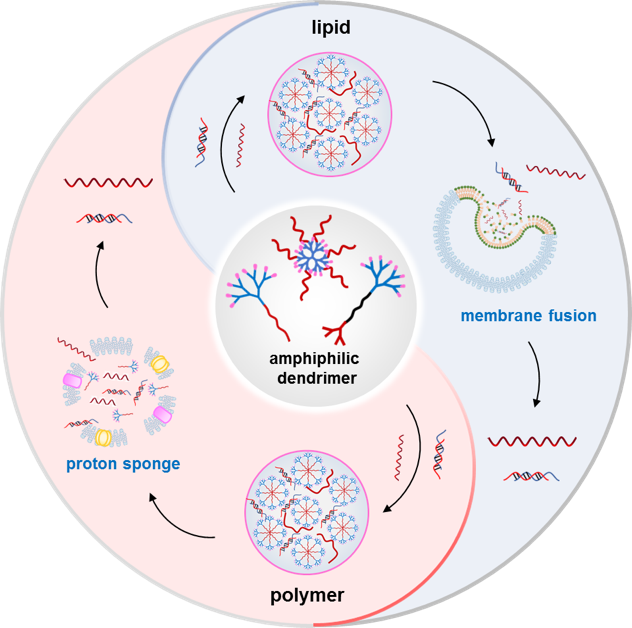
JANVIER 2021
- Welcome Ms Kaiyue ZHANG
We welcome Ms. Kaiyue ZHANG to join our group for his PhD program. We wish her all the best with pleasant and productive stay in our group.
- New projects in 2021
We start three new projects in 2021:
1) Equipe Labellisée Ligue Nationale Contre le Cancer,
“Modular nanosystems for multimodal imaging and theranostics to fight against cancer”
2) EU H2020 ERA-NET EuroNanoMed III
“Reactivation of antitumor immune responses in gliomas using nanotechnology based targeted delivery (iNanoGun)”
3) EU H2020 Marie-Curie ITN project 956070
“Oligonucleotides for Medical Applications (OLIGOMED)”
https://www.southampton.ac.uk/oligomed/index.page
- Nouvel article:
Self-Assembling Supramolecular Dendrimers for Biomedical Applications: Lessons Learned from Poly(amidoamine) Dendrimers
Zhenbin Lyu, Ling Ding, Aura Tintaru, and Ling Peng
Acc. Chem. Res. 2020, DOI:10.1021/acs.accounts.0c00589
Dendrimers, notable for their well-defined radial structures with numerous terminal functionalities, hold great promise for biomedical applications such as drug delivery, diagnostics, and therapeutics. However, their translation into clinical use has been greatly impeded by their challenging stepwise synthesis and difficult purification. In this paper, we provide out-of-box thinking about constructing non-covalent supramolecular dendrimers via self-assembling of small amphiphilic dendrimers, which are easy to synthesize. Using poly(amidoamine) (PAMAM) dendrimers as examples, the self-assembled supramolecular dendrimers mimic covalent dendrimers not only in the structure but also in their capacity for biomedical applications. Some of the reported supramolecular dendrimers exhibit outstanding performance, excelling the corresponding clinical anticancer therapeutics and imaging agents. This self-assembly approach to creating supramolecular dendrimers is completely novel in concept yet easy to implement in practice, offering a fresh perspective for exploiting the advantageous features of dendrimers in biomedical applications.

Figure: Cartoon representations of self-assembly supramolecular dendrimer for the delivery of hydrophobic and hydrophilic pharmaceutical agents as well as negatively charged nucleic acid
therapeutics.
Contact:
Dr. Ling Peng,
Email: ling.peng@univ-amu.fr
Aix-Marseille Université, CNRS, Centre Interdisciplinaire de Nanoscience de Marseille (CINaM) UMR 7325, Equipe Labellisé par La Ligue, Marseille, France
DECEMBRE 2020
- Un nouvel article dans Nature Protocol sur la synthèse et l'utilisation d'un dendrimère amphiphile pour la délivrance de petits ARN interférents (siRNA) dans les cellules immunitaires primaires
Jiaxuan Chen, Aleksandra Ellert-Miklaszewska, Stefano Garofalo, Arindam K Dey, Jingjie Tang, Yifan Jiang, Flora Clément, Patrice N Marche, Xiaoxuan Liu, Bozena Kaminska, Angela Santoni, Cristina Limatola, John Rossi, Jiehua Zhou, Ling Peng
Nat. Protocols. 2020, DOI: 10.1038/s41596-020-00418-9
La manipulation génétique des cellules immunitaires à l'aide de petits ARN interférents (siRNA) est importante à la fois pour les études immunologiques et les applications thérapeutiques. Cependant, la délivrance de siRNA est difficile car les cellules immunitaires sont souvent sensibles aux réactifs de transfection standard et génèrent des réponses immunitaires. Pour contourner ces problèmes, nous avons développé un dendrimère amphiphile innovant, qui est particulièrement performant pour la délivrance de siRNA à un large éventail de types de cellules, y compris des cellules immunitaires primaires, telles que les cellules mononucléées du sang périphérique humain (PBMC), lymphocytes T et B humains, les cellules NK (humaines et de souris), les macrophages primaires dérivés de monocytes et les cellules microgliales primaires (de rat et de souris). Notamment, ce dendrimère est capable de former de petites nanoparticules stables avec le siRNA, protégeant ainsi le siRNA de la dégradation et facilitant son absorption cellulaire. L’arrêt de l’expression génique médié par le siRNA est spécifique et efficace à la fois au niveau de l'ARNm et des protéines, conduisant à des effets biologiques consécutifs. De manière remarquable, ce dendrimère n'induit pas de toxicité cellulaire apparente ou de réponses immunitaires non spécifiques dans des conditions expérimentales. Par conséquent, il constitue le réactif de transfection idéal pour la délivrance de siRNA dans les cellules immunitaires primaires et offre de nouvelles perspectives pour les études fonctionnelles et thérapeutiques du système immunitaire.
Il s'agit d'un travail collaboratif entre le Centre Interdisciplinaire de Nanoscience de Marseille (CINaM) de l'Université d'Aix-Marseille, l'Institut pour l'Avancée des Biosciences de l’Université Grenoble-Alpes (INSERM U1209, CNRS UMR5309), Sapienza University of Rome et IRCCS Neuromed en Italie, Nencki Institute of Experimental Biology en Pologne, China Pharmaceutical University en Chine et Beckman Research Institute aux États-Unis.
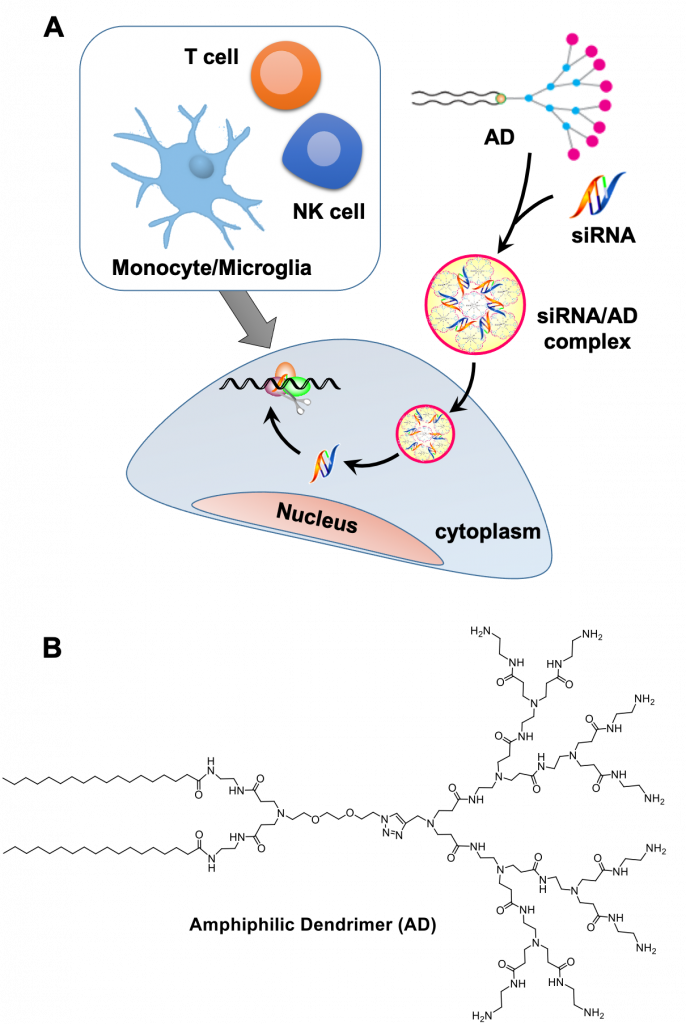
Figure: (A) Illustration de la livraison de siRNA médiée par le dendrimère AD dans diverses cellules immunitaires, y compris les cellules T, les monocytes/microglie et les cellules NK. (B) La structure du dendrimère AD.
Contact:
Dr. Ling Peng,
Email: ling.peng@univ-amu.fr
Aix-Marseille Université, CNRS, Centre Interdisciplinaire de Nanoscience de Marseille (CINaM) UMR 7325, Equipe Labellisé par La Ligue, Marseille, France
- Congratulations to Zhenbin Lyu and Ling DING for their PhD defense.
Congratulation to Zhenbin Lyu and Ling DING for their PhD thesis defense on 27/11/2020 and 30/11/2020. We wish both of them all the best for future endeavor and successful career ahead.
- Welcome Mr. Akshay Hande
We welcome Mr. Akshay Hande in our group, he has joined as Ph.D. on 1 December 2020. We wish him all the best with pleasant and productive stay in our group.
NOVEMBRE 2020
- Nouvelle publication: Un nanosystème de dendrimères supramoléculaires ionisables pour la délivrance efficace de siRNA avec un profil de toxicité favorableDinesh Dhumal, Wenjun Lan, Ling Ding, Yifan Jiang, Zhenbin Lyu, Erik Laurini, Domenico Marson, Aura Tintaru, Nelson Dusetti, Suzanne Giorgio, Juan Lucio Iovanna, Sabrina Pricl, and Ling PengNano Research, https://doi.org/10.1007/s12274-020-3216-8http://www.thenanoresearch.com/upload/justPDF/3216.pdf
La thérapie génique utilisant de petits ARN interférents (siRNA) émerge comme une nouvelle approche médicale dans le traitement des diverses maladies. Cependant, la délivrance de siRNA constitue toujours le principal obstacle à la mise en œuvre clinique. Notre étude porte sur la conception de vecteur dendritique supramoléculaire ionisable, formé par autoassemblage d'un petit dendrimère amphiphile, et qui constitue un système efficace de délivrance de siRNA, avec un profil de toxicité favorable. Grâce à ses groupements terminaux constitués d’amine tertiaires ionisables, le dendrimère supramoléculaire a un faible potentiel de surface chargé positivement et donc, une cytotoxicité négligeable. Néanmoins, cette caractéristique confère au dendrimère la capacité de former un complexe stable avec siRNA via des interactions électrostatiques. Celui-ci facilitera l’absorption cellulaire de siRNA et aussi une libération endosomale favorables de siRNA. Ce système de délivrance de siRNA a contribué à l’inhibition et l’extinction des oncogènes Myc et Akt2 avec un effet antiprolifératif, surpassant le vecteur de référence, la lipofectamine 2000. Par conséquent, ce dendrimère supramoléculaire ionisable représente un vecteur prometteur pour la délivrance de siRNA. Le concept de nanovecteurs basés sur des dendrimères supramoléculaires, formés par autoassemblage, est novateur et facile à mettre en œuvre dans la pratique, ouvrant de nouvelles perspectives pour l'utilisation de la chimie supramoléculaire dans les applications biomédicales.
Il s'agit d'un travail collaboratif entre le Centre Interdisciplinaire de Nanoscience de Marseille (CINaM), le Centre de Recherche en Cancerologie de Marseille (CRCM), Institut de Chimie Radicalaire (ICR) à Marseille en France, et Université de Trieste en Italie.
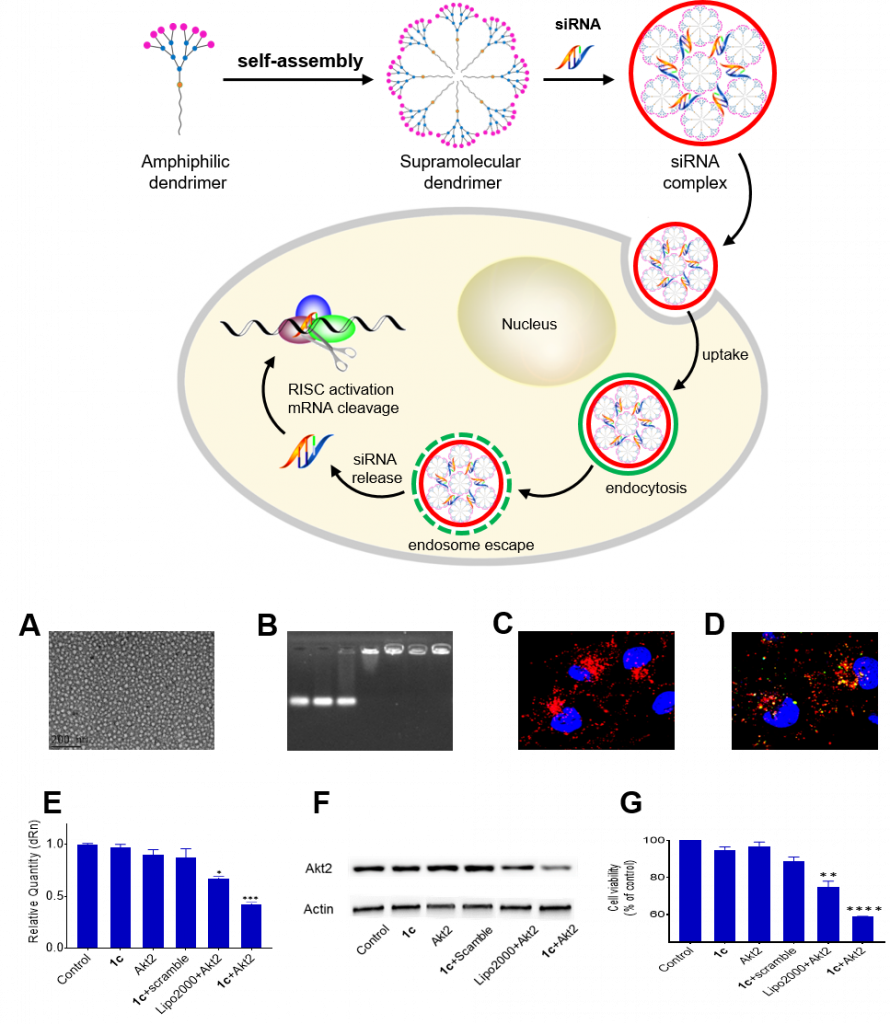
Figure: Schematic illustration of the supramolecular dendrimer formed via self-assembly of an ionizable amphiphilic dendrimer for siRNA delivery. (A) A representative transmission electron microscopy (TEM) image of the supramolecular dendrimer nanomicelles formed by ionizable tertiary amine terminated dendrimer, (B) complex formation between siRNA and the ionizable supramolecular dendrimer, (C) Cellular uptake of the (Cy3)-labeled siRNA/dendrimer complexes in human pancreatic cancer (Panc-1) cells revealed using confocal microscopic imaging, (D) siRNA release upon endosomal escape, siRNA-mediated gene silencing of the oncogenes Akt2 (E) at mRNA level assessed using qRT-PCR and at (F) protein level using western blotting, and (G) the resulting antiproliferative effect on Panc-1 cells determined using MTT assay.
- Congratulations to Wenjun LAN for her PhD defense.
Congratulation to Wenjun LAN for successfully defending her PhD thesis on 9/11/2020. We wish her all the best for future endeavor and successful career ahead.
- Congratulations! The project “Reactivation of antitumor immune responses in gliomas using nanotechnology based targeted delivery (iNanoGUN)” in which our group is a partner, has been accepted for funding under the Frame of EU H2020 ERA-NET EuroNanoMed III!
OCTOBRE 2020
- Bienvenue à Mme Xi LIU qui rejoint notre groupe pour son programme de doctorat. Nous lui souhaitons un agréable séjour dans notre groupe et tout le meilleur pour son doctorat.
- Félicitations au Dr. Dinesh Dhumal, Wenjun Lan, Ling Ding, Dr. Yifan Jiang et Zhenbin Lyu pour leur publication acceptée
Le manuscrit intitulé "An ionizable supramolecular dendrimer nanosystem for effective siRNA delivery with a favorable safety profile" et co-signées par Dr. Dinesh Dhumal, Wenjun Lan, Ling Ding, Dr. Yifan Jiang and Zhenbin Lyu, a été accepté par le journal "Nano Research".
- Félicitations au Dr. Dinesh Dhumal pour le prix de la meilleure présentation orale à MatSAN !
Dinesh Dhumal a remporté le prix Jeune Chercheur IMBL pour la meilleure communication orale à MatSAN 2020 en présentant son travail post-doctoral sur le nanosystème de dendrimère supramoléculaire pour la délivrance de siRNA dans le traitement du cancer. Nous le félicitons pour sa réussite.
- Félicitations à Wenjun Lan pour son mariage !

Nous félicitons Wenjun pour son mariage avec Jeremy le 17 octobre 2020, et leur souhaitons tout le bonheur du monde.
21 janvier 2020
Dans des travaux publiés dans la revue Nanomedicine, une méthode a permis d’interrompre la production d’ARN messager et de protéines de certains gènes, avec des effets biologiques importants.
De nombreuses pathologies cérébrales, telles que la maladie d’Alzheimer, de Parkinson ou certaines scléroses, sont associées à des altérations aigues ou chroniques des microglies, la principale défense immunitaire du cerveau. L’utilisation de petits ARN interférants (siRNA) pourrait permettre une manipulation génétique des fonctions microgliales, afin de soigner ces maladies, mais est actuellement entravée par l'absence de méthodes efficaces et inoffensives de livraison de siRNA dans les microglies. En particulier, les vecteurs actuellement disponibles affectent souvent les fonctions et les réponses basales des microglies. Une équipe du CINaM (CNRS/Université Aix-Marseille) a développé et validé un nanovecteur, sous la forme d’une molécule dendrimère (à branches), qui répond à ce défi. En se complexant aux siRNA pour former de petites nanoparticules robustes, ce dendrimère amphiphile cationique facilite l’entrée des siRNA dans les microglies primaires. Dans ces travaux publiés dans la revue Nanomedicine, cette méthode a permis d’interrompre la production d’ARN messager et de protéines des certains gènes, avec des effets biologiques importants : elle a par exemple empêché des cellules tumorales de stimuler les microglies à leur avantage, sans altération non désirée ou toxique pour les microglies. Il s’agit donc du premier vecteur qui livre des siRNA fonctionnels sans affecter les fonctions et réponses microgliales basales. Un outil prometteur pour les études génomiques fonctionnelles et thérapeutiques de divers modèles de maladies du système nerveux central.
Références:
Aleksandra Ellert-Miklaszewska, Natalia Ochocka, Marta Maleszewska, Ling Ding, Erik Laurini, Yifan Jiang, Adria-Jaume Roura, Suzanne Giorgio, Bartlomiej Gielniewski, Sabrina Pricl, Ling Peng & Bozena Kaminska
Efficient and innocuous delivery of small interfering RNA to microglia using an amphiphilic dendrimer nanovector
DOI : 10.2217/nnm-2019-0176
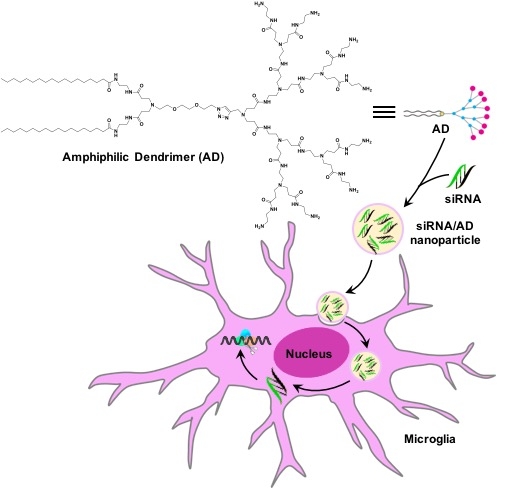
Formation du complexe siRNA/dendrimère, son entrée dans la cellule via l'endocytose et sa libération de l'endosome dans le cytosol pour le silençage génique © Ling DING
12 décembre 2019
Un nouvel article a été publié dans Chemical Communications:
A self-assembling amphiphilic dendrimer nanotracer for SPECT imaging
Ling Ding, Zhenbin Lyu, Aura Tintaru, Erik Laurini, Domenico Marson, Beatrice Louis, Ahlem Bouhlel, Laure Balasse, Samantha Fernandez, Philippe Garrigue, Eric Mas, Suzanne Giorgio, Sabrina Pricl, Benjamin Guillet, Ling Peng
Chem. Commun. 2019, doi: 10.1039/c9cc07750b
L’imagerie médicale joue un rôle important dans le diagnostic et le traitement du cancer. La tomographie par émission monophotonique (TEMP) est la modalité d'imagerie isotopique la plus répandue en soin clinique. Aujourd’hui, l’amélioration de la sensibilité et surtout de la spécificité de l’imagerie TEMP, représente un défi majeur. L'imagerie basée sur les nanotechnologies est particulièrement prometteuse pour répondre à ce challenge, car les agents d'imagerie peuvent cibler spécifiquement les tumeurs via l'effet EPR (résultant d’une augmentation de la perméabilité vasculaire et de la rétention tumorale) et donc augmenter la sensibilité et la spécificité de l'imagerie tumorale. Dans ce travail, nous présentons un nanosystème pour TEMP basé sur un dendrimère amphiphile portant plusieurs unités aux extrémités permettant leur utilisation pour l’imagerie TEMP. Ce dendrimère est capable de s'auto-assembler en nanomicelles de taille de 18 nm, qui s'accumulent dans les tumeurs pour une imagerie efficace par TEMP (voir le Figure ci-dessous). Bénéficiant à la fois de la multivalence dendrimérique et du ciblage des tumeurs par l’effet EPR, ce nanosystème dendrimérique constitue une approche efficace et prometteuse pour l’imagerie du cancer. Les travaux présentés dans cet article, dans la continuité de nos précédents travaux sur l'imagerie par la tomographie par émission de positons (TEP) et le transport de médicaments, témoignent du fort potentiel des nanosystèmes formés à partir de dendrimères auto-assemblés en tant que plateformes innovantes et robustes pour diverses applications biomédicales.
Il s'agit d'un travail collaboratif entre le Centre Interdisciplinaire de Nanosciences de Marseille (CINaM) et le Centre Européen de Recherche en Imagerie Médicale (CERIMED) de l'Université d'Aix-Marseille, en collaboration avec l'Institut de Chimie Radicale (ICR), le Centre de Recherche en Cancérologie de Marseille (CRCM), le Centre de recherche CardioVasculaire et Nutrition (C2VN) et l’Université de Trieste en Italie.
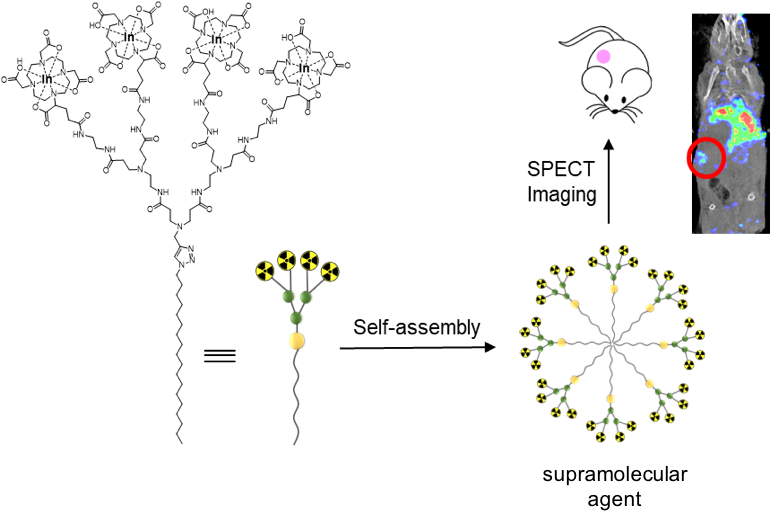
Figure 1: Illustration du nanosystème supramoléculaire de dendrimère, basée sur l’auto-assemblage d’un dendrimère amphiphile portant les radionucléides aux extrémités, pour l'imagerie de tumeurs par la tomographie par émission monophotonique (TEMP)
____________________________________________________________________________
4 juillet 2019:
Flavonoid-Alkylphospholipid Conjugates Elicit Dual Inhibition of Cancer Cell Growth and Lipid Accumulation, Zhengwei Zhou, Biyao Luo, Xi Liu, Mimi Chen, Wenjun Lan, Juan L. Iovanna, Ling Peng*, and Yi Xia*
Chemical Communications, 2019, DOI: 10.1039/C9CC04084F
L'article ici: 2019 ChemCommun XIA
Le cancer est un problème majeur de santé publique. Le développement du cancer est impacté non seulement par des facteurs génétiques, mais également par des facteurs environnementaux et sociétaux tels que l'obésité, le tabagisme, les infections, etc. En effet, les personnes obèses ou en surpoids ont souvent un risque plus élevé de développer une tumeur. Cela s’explique par des taux de lipides élevés, provoqués par une synthèse accrue et une accumulation aberrante de lipides, capables d’induire la tumorigénèse et d’accélérer l’apparition de métastases.
Nous decrivons ici, une série de nouveaux composés à double fonction ayant à la fois une activité anticancéreuse et la capacité de réduire l’accumulation de lipides. Ces composés sont des composés hybrides d’un produit naturel la quercétine et d’alkylphospholipides synthétiques (APL). La quercétine est un antioxydant flavonoïde qui affecte le métabolisme des lipides, alors que les APL ont une activité anticancéreuse prouvée. En effet, ces composés hybrides surpassent l’efficacité des composés modèles (la quercétine et les APL) en termes d’activité anticancéreuse, tout en supprimant de manière significative l’accumulation de lipides. Ils induisent également la diminution de la voie du choc thermique et des proteines anti-apoptotiques. Par conséquent, ces composés constituent un nouveau paradigme structurel prometteur dans la découverte de nouveaux candidats anticancéreux. Cette étude pourrait également ouvrir de nouvelles perspectives pour la mise au point d’agents thérapeutiques permettant de traiter d’autres maladies liées à l’accumulation de lipides, telles que les maladies cardiovasculaires, l’obésité, le diabète etc.
Figure 1. (A) Chemical structures of the natural product quercetin, the synthetic alkylphospholipid drugs miltefosine and edelfosine, and their conjugates Id and IIc developed in this work; (B) their antiproliferative activity against cancer cells; and (C) their inhibition on lipid accumulation in cancer cells.
A: B:
B: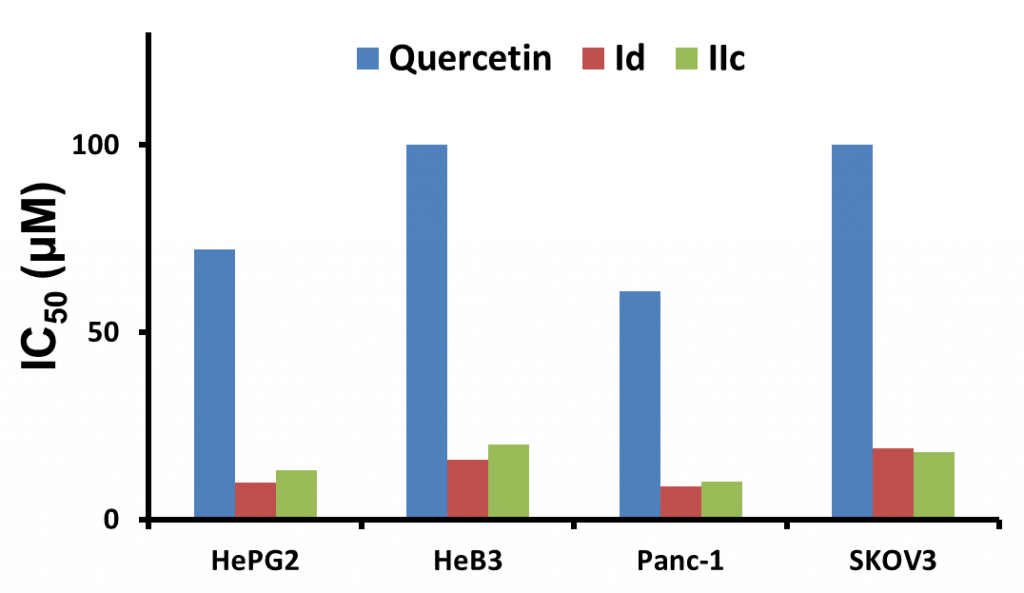 C:
C: Il s'agit d'un travail collaboratif entre l'Université de Chongqing en Chine, le Centre de Recherche en Cancérologie de Marseille (CRCM) et le Centre Interdisciplinaire de Nanosciences de Marseille (CINaM) en France dans le cadre du programme de coopération franco-chinois XU GUANGQI.
Il s'agit d'un travail collaboratif entre l'Université de Chongqing en Chine, le Centre de Recherche en Cancérologie de Marseille (CRCM) et le Centre Interdisciplinaire de Nanosciences de Marseille (CINaM) en France dans le cadre du programme de coopération franco-chinois XU GUANGQI.
- May 2-3, 2019: Kick-off meeting of the H2020 project SAFE-N-MEDTECH in Bilbao, Spain
- April 1, 2019: We started the H2020 NMBP project, “Safety testing in the life cycle of nanotechnology-enabled medical technologies for health (SAFE-N-MEDTECH)”
- March 1, 2019: We started the H2020 Era-Net EuroNanoMed project “Nanosystems conjugated with antibody fragments for treating brain infections” (TARBRAINFEC)
Press Release: SAFE-N-MEDTECH kicks off in Bilbao
The SAFE-N-MEDTECH initiative just kicked off last week in Bilbao, in a meeting hosted by Osteba, the HTA Unit of the Health Ministry of the Basque Country (Spain) in collaboration with BIOPRAXIS-BIOKERALTY. The project is coordinated by TECNAN (an SME from Navarra, with great experience in Nano products), together with BIOPRAXIS-BIOKERALTY (the research branch of the global health companies Keralty and Praxis).
The Project is part of the Open Innovation Test Bed(OITB) initiative from the European Commission, a new and challenging approach towards upscaling the use of nanotechnologies in Europe and abroad. It represents an investment of 18M€ for 4 years, concretely receiving 15M€ from the European Commission.
More than 50 people gathered in Bilbao, coming from 28 entities, from 13 countries to refine the basis of the collaboration, and set the scene for the first years of the Project.
Ambition and strategy
Society and clinical practice pose a growing demand on novel biomaterials, ICT, micro and nanotechnologies for innovative medical devices and in vitro diagnostics (Medical Technologies-MTs). In addition to the challenge of time, the new technologies are subjected to other pressing factors such as qualification, regulation, cost, biocompatibility and the need to be applicable worldwide. In the most recent years it is obvious that nano-enabled MTs can be applied in nearly every medical area, with a major presence and increased importance in cancer, regenerative medicine, advanced therapies, neurology, cardiology, orthopaedics, and dentistry.
SAFE-N-MEDTECH will build an innovative open access platform to offer to companies and reference laboratories, the capabilities, knowhow, networks and services required for the development, testing, assessment, upscaling and market exploitation of nanotechnology-based Medical and Diagnosis Devices.
SAFE-N-MEDTECH will offer a multidisciplinary and market oriented innovation approach to SME´s, Healthcare providers and Industries for the translation to the market of MTs, based on a deep understanding and knowledge of the material nanoproperties, their advance use and applications in MTs and other aspects involved in MTs safety (electric compatibility, electromagnetic properties, etc).
Who's in?
There are 28 partners in SAFE-N-MEDTECH, a great challenge for management, but a huge opportunity to address all the key challenges to come ahead. Research Institutes, Small and larger companies, Associations, Health Technology Assessment experts, Hospitals and Care centres are amongst the partners, and ensure the project can cover all the relevant aspects of the translation of nano-enabled medical technologies.
What's next?
SAFE-N-MEDTECH starts its journey by ensuring its validity with four test cases. During the first years of the initiative, the partners will develop their services and test them, so that in four years from now, it will become a self-sustainable and competitive services platform for companies to test and ensure their nano enabled MTs are safe to use!
For more info on the project:
Coordinator: Tamara Oroz, TECNAN (tamara.oroz@tecnan-nanomat.es) Scientific Lead: Angel del Pozo, Biopraxis –Keralty (angel.delpozo@keralty.com) Communication: Anaïs Le Corvec, Aura Costa (info@cebr.net)
- Ling Peng, Zvi Hayouka, Dinesh Dhumal, Einav Cohen, Zhenbin Lyu, "SELF-ASSEMBLING DENDRIMERS AND ANTIBACTERIAL USES THEREOF", US patent application date: May 18, 2022; Application N°: 63/343,121. Applicant: The Hebrew University of Jerusalem; Filing country: Israel
- Juan Iovanna, Jose Luis Neira, Yi Xia, Patricia Santofimia-Castaño, Wenjun Lan, Ling Peng, "NEW COMBINATION TO TREAT CANCER", European patent application date: Nov 27, 2019; Applicant: Inserm-Transfert; Filing country: France; Application N°: 2019, EP19306528.1.
- Juan Iovanna, Jose Luis Neira, Yi Xia, Patricia Santofimia-Castaño, Bruno Rizzuti, Olga Abian, Adrian Velazquez Campoy, Ling Peng, "NUPR1 INHIBITION FOR TREATING CANCER", European patent application date: May 31, 2018; Application N°: EP18305672.0.
- Alice Sze Tsai Wong, Jing Ma, Kwok Wai Lo, Ling Peng, "BCL3 siRNA amphiphilic dendriplexes for effective and potent nasopharyngeal carcinoma treatment", Application date: March 15, 2017; Application number: 15/459,806; US Patent Non-Provisional No. 15/459,806; Publication No. US2018/0265872A1.
- Ling Peng, Yi Xia, Palma Rocchi, Jinqiao Wan, Yang Liu, Menghua Wang, Fanqi Qu, Juan Iovanna, "Novel triazole nucleoside derivatives, their preparation and their application in therapeutics", 2008, EU 08 155481.8; 2009, PCT/EP2009/055213.; 2009, WO/2009/133147A1; US 2011/0136754A1.
- Ling Peng, Fanqi Qu, Ruizhi Zhu, Johan Neyt, "Novel Viral Replication Inhibitors", 2007, GB0714649.1; 2008, PCT/BE2008/000059; 2009, WO/2009/015446.
1)
EU project "SAFE-N-MEDTECH": https://safenmt.eu/
2)
EU COST Action CA17140 "NANO2CLINIC": https://www.nano2clinic.eu/cost-action-ca17140
